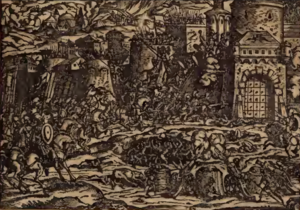Second Siege of Krujë (1466)
| Second siege of Krujë | |||||||
|---|---|---|---|---|---|---|---|
| Part of the Ottoman Wars in Europe | |||||||
 Second Siege of Krujë 1466 - Engraving by Jost Amman 1587 |
|||||||
|
|||||||
| Belligerents | |||||||
|
|
|
||||||
| Commanders and leaders | |||||||
|
|
|
||||||
| Strength | |||||||
| 4,400 garrisoned; 13,400 set to relieve Krujë | 30,000–100,000; 23,000 remained with Ballaban upon Mehmed's withdrawal | ||||||
The second siege of Krujë took place from 1466 to 1467. Sultan Mehmed II of the Ottoman Empire led an army into Albania to defeat Skanderbeg, the leader of the League of Lezhë, which was created in 1444 after he began his war against the Ottomans. During the almost year-long siege, Skanderbeg's main fortress, Krujë, withstood the siege while Skanderbeg roamed Albania to gather forces and facilitate the flight of refugees from the civilian areas that were attacked by the Ottomans. Krujë managed to withstand the siege put on it by Ballaban Badera, sanjakbey of the Sanjak of Ohrid, an Albanian brought up in the Ottoman army through the devşirme. By 23 April 1467, the Ottoman army had been defeated and Skanderbeg entered Krujë.
Mehmed had decided to construct a fortress in what is now Elbasan which would provide a perennial base for future Ottoman assaults on Skanderbeg's domains. The fortress especially worried Venice since Elbasan was constructed on the banks of the Shkumbin River which would allow the Ottomans to send ships into the Adriatic and threaten Venetian colonies. Seeing that his situation had become unfavorable, Skanderbeg made a trip to Italy where he would try to convince Pope Paul II and Ferdinand I of Naples to give him aid for his war. Despite many promises from the pope, Skanderbeg received little due to the fear of a Neapolitan war with Rome and infighting in the Roman Curia. Ferdinand and the Republic of Venice likewise deferred Skanderbeg's requests to the pope. By the time he left Italy, the League of Lezhë had been weakened and needed his intervention.
After his return the Venetians decided to send troops against the Ottoman advances. Skanderbeg gathered 13,400 men, among whom were many Venetians, to launch an assault on the Ottoman besieging camp, who had taken command once Mehmed left Albania after the construction of Elbasan. Skanderbeg had split his army into three parts and surrounded the besiegers. Ballaban was killed during the fighting and the Ottoman forces were left without a commander and a depleted force which was surrounded. Afterwards the Albanian-Venetian forces completed the rout by killing the remaining Ottoman forces before they could escape by way of Dibër. The victory was well received by both Albanians and Italians. This did not signal the end of the war, however, as soon after, Skanderbeg took up some assaults on Elbasan after being urged to by Venice, but was not able to take the fortress due to lack of artillery. Venice itself was in conflict with its Italian neighbors, which led Mehmed to begin another campaign against the Albanians. This would result in another siege on Krujë.
...
Wikipedia
